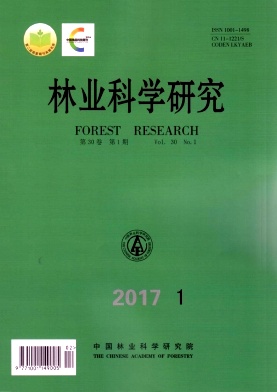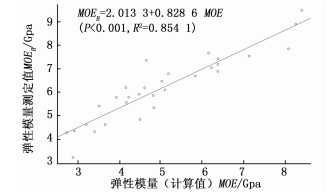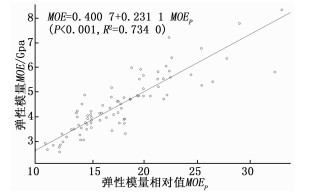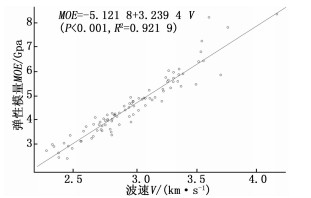-
为培育速生优质林木良种, 需要大规模对遗传测定群体活立木材性等重要品质性状开展无损评估。其中, 弹性模量(MOE)是林木建筑用材最重要的力学性质, 能够反映木材的韧性和抵抗变形的能力, 木材的弹性模量越大, 在承受荷载时其变形越小[1-2]。目前, 已成功应用于活立木弹性模量无损评估的是基于应力波速法的AV技术, 它通过测量应力波在开始探头和结束探头之间的传播时间来测得AV值(波速V), 该数值与立木强度具有显著的相关性, 可以作为活立木强度的检测工具[3-5]。Ross等[6]采用应力波检测方法得出木材的弹性模量(MOE)、木材密度(ρ)和应力波速度的关系式: MOE=ρV2, 这为应力波速技术在木材弹性模量无损检测提供了研究基础[7-9]。活立木木材基本密度(ρ)测定的常规方法是用生长锥在其胸径处取木芯, 然后利用饱和含水量法进行测定[10], 虽然该方法获得的数据直观、可靠, 但是成本高、耗时长、具破坏性。Pilodyn是应用最为普遍的一种基于阻力的活立木密度无损快速检测仪器[11-12], 有效地克服了传统检测方法的缺点, 在活立木木材密度评估中已有一定的进展[13-17]。在实现了应力波速(V)和基本密度(ρ)无损评估的基础上, Chen等[5, 18]综合利用了Pilodyn和AV技术, 以Pilodyn探测值估测的木材外部密度作为木材基本密度, 对挪威云杉(Picea abies (L.) H. Karst.)大群体MOE和基本密度(ρ)进行了估测, 首次实现了数千株大群体活立木材性性状的遗传变异分析。
湿地松(Pinus elliottii Engelman var. elliottii)原产于美国东南部, 现已成为我国南方重要的用材树种[19-21]。经过数十年的育种工作, 湿地松生长性状获得较大的改良[22-24], 以弹性模量为代表的力学性状由于受测定技术影响改良进程缓慢[25-28]。因此, 开发操作简单方便、破坏性小且结果可靠的弹性模量无损评估技术, 实现以大群体试验材料为基础的遗传选择和评估, 对提高遗传测定的精度与效率、促进遗传改良进程具有重大现实意义。本研究采用力学阻力仪(Pilodyn)和应力波速记录仪(AV)等活立木无损评估仪器和方法以及木材物理力学常规检测方法, 初步建立湿地松活立木弹性模量评估技术体系, 为湿地松弹性模量等材性性状遗传改良奠定基础, 同时对其它树种材性测定具有参考意义。
HTML
-
试验地位于浙江省杭州市余杭区长乐林场(30°27′ N, 119°48′E), 亚热带湿润季风性气候, 年均降水量1 399 mm, 年均气温16.1℃, 属低山缓坡, 土壤以红壤为主。
试验林为湿地松子代测定林, 营建于1994年春季, 含33个半同胞家系, 采取单行6株小区、6个重复的随机完全区组设计。
-
2015年12月对上述33个湿地松半同胞家系进行取样测定, 随机选取6个重复中的3个重复, 其中, 每个小区选取1株平均木作为样木, 总计99个单株, 进行Pilodyn(6J, PROCEQ, Switzerland)单株测定[5, 29]。在样木胸高南、北向分别测定2次(若2次探测值差值大于2 mm, 则进行第3次探测, 选择3次探测差异最小的2个值作为有效探测值), 取2次测定的平均值作为南向的Pilodyn值(Ps)和北向的Pilodyn值(Pn), 并取南、北向的平均值作为Pilodyn测定值(Pr)。
-
Pilodyn测定后, 用内径为5 mm的生长锥在样木胸高处南北向钻取木芯(木芯穿透样木)。基本密度(ρ)采用饱和含水量法测定[10], 其计算公式如下:
式(1)中: ρ为基本密度(g·cm-3); Gmw为饱和含水率时试样的质量(g); Gh为绝干时试样的质量(g)。
-
利用活立木AV值测量专用工具Hitman ST300(Fibre-gen, Christchurch, New Zealand)对选择的样木进行测量, 获得AV值(V)[30]。分别将传输探头(Transmit Probe, Tx)和接收探头(Rx)以45°角敲进样木树干(探头敲进树干深度一般大于10 mm, 以确保探头能够达到样木边材且保持探头稳定, 同时要求传输装置和接受装置位于树干同一垂直方向且保持水平), 其中, Tx和Rx之间间隔100 cm左右。每有效敲击Tx 8次, 数据记录器(PDA)就会自动得出本轮8次敲击的平均波速V1, 为提高测定精度, 需敲击2~3轮, PDA则会自动计算并保存该2~3轮敲击所得波速(V1、V2、V3)的平均值V, 即为该样木的AV值。
-
根据生长锥法和AV技术得出的测定值ρ和V, 应用公式MOE=ρV2计算出各样木的弹性模量(即弹性模量计算值, 本文中以MOE表示); 根据Pilodyn法和AV技术得出的测定值Pr和V, 以Pr代替ρ, 应用上述公式计算出各样木的弹性模量相对值MOEP(MOEP=PrV2)。
-
在99株样木中随机选取30株样木依据国家标准《GB/T 1929-2009木材物理力学试材锯解及试样截取方法》进行破坏性取样, 并委托浙江省林科院质检站按照国家标准《GB/T 1936.2-2009木材抗弯弹性模量测定方法》测定其抗弯弹性模量(即弹性模量测定值, 本文中以MOEB表示)。
-
数据分析在R软件(v 3.1.3, CRAN, http://cran.r-project.org)上进行。
(1) 各指标间的相关性分析利用R软件中的corr. test()函数计算Pearson相关系数r并进行显著性检验。
(2) MOEB和MOE、MOE和MOEP以及MOE和V之间的回归分析均基于普通最小二乘法(OLS), 利用R软件中的lm()函数拟合其简单线性回归模型:
式(2)~(4)中: b1、b2、b3代表回归常数, k1、k2、k3代表回归系数。
2.1. 材性性状指标测定方法
2.1.1. Pilodyn测定
2.1.2. 基本密度生长锥测定
2.1.3. 应力波速V测定
2.1.4. 弹性模量评估
2.1.4.1. 无损评估
2.1.4.2. 常规测定
2.2. 统计分析方法
-
99个湿地松单株材性性状各测定指标的基本情况见表 1。湿地松木材基本密度和弹性模量分别为0.502 0 g·cm-3、4.495 6 GPa, 其中, MOEP极差与方差均较大, 说明弹性模量值变异丰富, 这可能是由于MOEP计算时因子Pr与V2的乘积引起的MOEP值波动较大, 可能会有较好的遗传选择成效。基本密度性状测定指标(ρ、Pr)变异系数较小(CV < 10%), 弹性模量性状测定指标(MOE、MOEP)变异系数较大(CV > 20%), 也说明湿地松弹性模量性状相对于基本密度性状具有更丰富的遗传变异性。
项目Item 均值Mean 最小值Min 最大值Max 极差Range 标准误SE 方差Variance 变异系数CV/% 基本密度p/(g • cm-3) 0.502 0 0.390 0 0.629 4 0.2394 0.0039 0.0014 7.5766 Pilodyn 测定值 Pr/cm 1.987 0 1.625 0 2.3800 0.7550 0.0177 0.0299 8.7086 波速 V/(km • s-1 ) 2.968 9 2. 275 0 4.1710 1.896 0 0.0375 0.1353 12.3878 弹性模量MOE/GPa 4.495 6 2.3370 8.349 4 6.012 4 0.1273 1.5547 27.7359 弹性模量相对值MOEp 17.6875 10.549 8 33.054 8 22.5050 0.5056 21.9850 26.9053 Table 1. Basic information of determination of wood density and MOE of slash pine
-
对湿地松木材基本密度性状测定指标(ρ、Pr)和弹性模量性状测定指标(V、MOE、MOEP)进行相关分析, 结果见表 2。从表 2中可以看出: ρ与Pr呈显著负相关关系(P < 0.01), 而这二者基本密度性状测定指标与3个弹性模量性状测定指标之间相关关系不显著或显著性低(P < 0.1);V与MOE及MOEP达到极显著的高度正相关(r > 0.90, P < 0.001)。这说明波速是影响湿地松弹性模量估测的关键因子, 木材密度对弹性模量影响相对较小, 而MOE与MOEP之间也呈极显著高度正相关(r =0.85, P < 0.001), 因此, 可以认为MOEP也可以对MOE进行预测和评估。
项目Item 基本密度P Pilodyn 测定值 Pr 波速V 弹性模量MOE 弹性模量相对值MOEp 基本密度p -0.35** 0.20 0.25* -0.04 (0.01) (0.25) (0.08) (0.73) Pilodyn 测定 -0.11 -0.16 0.19 值Pr (0.62) (0.30 ) (0.28) 波速v 0. 96 *** 0 93 *** ( 0.00 (0.00) 弹性模量 0. 85 *** MOE (0.00) 弹性模量相对 值 MOEp 注: 括号中为该相关系数显著性水平; *代表显著性水平为0.1, **代表显著性水平为0.01, ***代表显著性水平为0.001。
Note: Significance probability of the correlations were given in parenthesis; *, **, *** represent P < 0.05, P < 0.01 and P < 0.001, respectively.Table 2. The correlations of determination of wood density and MOE indexes of slash pine
-
湿地松弹性模量测定值与弹性模量(计算值)的线性回归模型为MOEB=2.013 3+0.828 6MOE, 其决定系数R2=0.854 1(图 1)。模型中, 回归常数和回归系数都达极显著水平(P < 0.001), 即MOEB与MOE呈极显著线性相关关系。因此, 利用关系式MOE=ρV2得出的湿地松弹性模量计算值MOE虽然不能作为其标准值, 却完全可以代表弹性模量测定值进行评估与选育。
-
湿地松弹性模量与弹性模量相对值的线性回归模型为MOE=0.400 7+0.231 1MOEP, 其决定系数R2为0.734 0(图 2)。模型中, 回归常数(P < 0.05)和回归系数(P < 0.001)都达显著水平, 这说明该线性模型适合于MOE与MOEP之间的回归分析, 也就是说利用Pilodyn法和AV技术得出的测定值Pr和V, 计算出MOEP并应用以上模型即能快速评估弹性模量。
-
湿地松弹性模量与波速的线性回归模型为MOE=-5.121 8+3.239 4V, 其决定系数R2为0.921 9(图 3)。模型中, 回归常数和回归系数也都达极显著水平(P < 0.001), 该模型的方差解释率为91.19%, 这说明该线性模型能很好地拟合MOE与V之间的线性回归关系, 即仅利用AV技术也能实现弹性模量评估。
3.1. 各测定指标的基本情况
3.2. 各测定指标间相关性分析
3.3. 弹性模量测定值和弹性模量(计算值)的回归方程
3.4. 弹性模量(计算值)和弹性模量相对值的回归方程
3.5. 弹性模量(计算值)和波速的回归方程
-
弹性模量与树木本身抵抗倒伏能力密切相关[31]。湿地松作为当前我国南方最重要的用材、采脂及荒山绿化优良树种, 种植面积超过200万hm2, 然而, 由于前期研究工作对其抗风雪等力学性质的选择力度不够, 部分地区湿地松遇到异常天气情况出现雪压、风倒等灾害, 成为制约该树种发展的一个重要方面[32], 因此, 从树种健康角度考虑, 需要继续加强其弹性模量等物理力学性质的评估与选育研究。随着无损评估技术的发展, 全林选择测定湿地松弹性模量成为可能。本研究以力学阻力仪(Pilodyn)和应力波速记录仪(AV)等活立木无损评估仪器和方法, 初步建立湿地松活立木弹性模量评估技术体系, 为湿地松弹性模量等材性性状遗传改良奠定基础, 同时对其它树种测定具有参考意义。
自Ross等[6]研究得出关系式MOE=ρV2以来, 基于应力波速法的AV技术在雪松(Cedrus deodara (Roxb.) G. Don.)[7]、欧洲赤松(Pinus sylvestris L.)[8]、火炬松(Pinus taeda L.)[33]、杉木(Cunninghamia lanceolata (Lamb.) Hook.)[9]等树种活立木MOE评估中的研究应用逐渐成熟, 为湿地松大群体活立木弹性模量的快速评估奠定了基础。本研究结果也显示出湿地松弹性模量测定值与弹性模量(计算值)之间存在着极显著的线性相关关系, 其线性回归模型为MOEB=2.013 3+0.828 6MOE, 决定系数R2=0.854 1。可以看出, 在湿地松弹性模量评估中, 关系式MOE=ρV2不能得出其标准弹性模量值, 但这并不能否定该关系式的应用价值, 在湿地松无损、快速评估及其遗传改良研究进程中, 其仍具有相当大的优势, 完全可以代表弹性模量测定值进行评估与选育。
湿地松木材基本密度性状测定指标和弹性模量性状测定指标相关分析结果显示: 基本密度ρ与Pilodyn测定值Pr呈显著负相关关系。直接以Pr值代替ρ计算的弹性模量相对值MOEP与弹性模量MOE之间呈极显著的高度正相关关系, 回归模型MOE=0.400 7+0.231 1MOEP, 因此, 在不要求精确获取各样木弹性模量绝对值时, 可直接利用MOEP作为各样木的弹性模量值参与遗传分析。以Pr值代替ρ计算的弹性模量相对值MOEP较之先前弹性模量无损评估研究而言, 节省了测定相应木材基本密度的工作量[8-9], 具有一定的便利优势, 可在现实工作中应用。同时, 相关性研究中还发现, 基本密度性状测定指标(ρ、Pr)与弹性模量性状测定指标(MOE、MOEP)之间相关关系不显著或显著性较低, 波速V与弹性模量MOE以及弹性模量相对值MOEP则均达到极显著高度正相关, 说明波速V是弹性模量间接估测中的关键因子, 而木材密度对其影响相对较小。弹性模量MOE与波速V之间的线性回归模型MOE= -5.121 8+3.239 4V, 该模型很好地拟合了本研究中MOE与V之间的线性关系。可能受试验材料影响, Wu等[34]以22个4年生桉树(Eucalyptus spp.)无性系为研究对象, 结果认为Pilodyn与弹性模量呈显著负相关, 而本研究中结果显示, 尽管这二者之间存在负相关关系, 但相关是不显著的, 与Chen等[5]对5 618株挪威云杉材性无损测定的结果相同。因此, 木材基本密度与弹性模量之间的相关性受试验对象或环境条件影响较大, 不同研究对象评估时需要建立对应的评估模型。
一般认为弹性模量由物体基本密度(ρ)和应力波速(V)共同决定, 由经验方程MOE=ρV2可以看出V的影响应该更大, 本研究中仅应用V就能很好地预测弹性模量, 可以将公式中ρ看作是一个常数, 这和Kennedy等[9]的观点一致, 为活立木弹性模量的简单快速预测奠定了基础, 同时研究中直接用Pilodyn测定值Pr代替ρ计算的弹性模量估计值MOEP也可以作为活立木弹性模量的参考值。
-
(1) 湿地松弹性模量测定值MOEB与弹性模量(计算值)MOE之间存在极显著线性相关关系, 在遗传选择时MOE完全可以代表弹性模量测定值进行评估与选育。
(2) 弹性模量相对值MOEP与弹性模量MOE之间呈极显著高度正相关关系, 回归模型MOE=0.400 7+0.231 1MOEP, 可直接利用MOEP作为各样木的弹性模量值参与遗传分析。
(3) 弹性模量MOE与波速V之间的线性回归模型MOE=-5.121 8+3.239 4V, 在比较同一测定群体弹性模量值相对大小时也可直接比较V值, 大大减少了工作量。
以上建立的模型对其它树种测定具有参考意义, 但尚需检验。









 DownLoad:
DownLoad:

